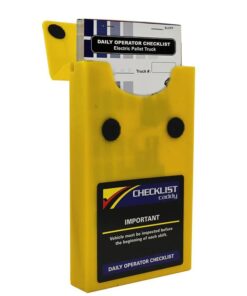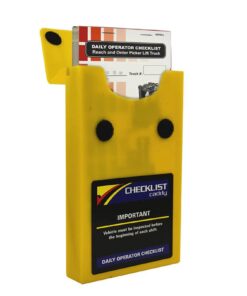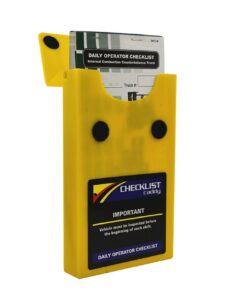Forklift Safety, Forklift Training
The Importance of Performing a Pre-Operation Forklift Inspection
The Importance of Performing a Pre-Operation Forklift Inspection
Published by
on
Today I am writing about the importance of performing a pre-operation forklift inspection. Besides the fact that it is required by OSHA it’s also a good idea from a business perspective. The information in this post only focuses on the OSHA requirement. I will address the importance of a pre-operation forklift inspection from a business perspective in a later post.

OSHA requires that all forklifts be examined at the beginning of each shift (before being placed in service). Forklifts used on a round-the-clock basis must be examined after each shift – 29 CFR 1910.178(q)(7). The thought behind this requirement is really quite simple. The operating of a lift truck that is in need of any repair could put the operator or others in the workplace in unnecessary danger.
When I am leading an operator training class I stress the importance of the pre-operation forklift inspection. I explain that they are for their benefit and those around them. The last thing any company wants is an injured operator or pedestrian.
There have been some in my class that have made comments similar to the following: “by the time I complete the pre-operation forklift inspection half of my work day is gone”. To this and similar comments on this subject, I simply state the following “barring any major problems most inspections should take between 5 – 15 minutes (on average) and that time is well spent if an accident due to a maintenance/operational problem can be avoided.
During the training I discuss the importance of following the two step process. The first is to inspect the forklift truck with the key in the off position. The following are some of the items I discuss that should be inspected. It’s best to check with the operator’s manual to get the complete list of items (note: this is not intended to be a complete list).
- General condition and cleanliness of the forklift
- Look around where you will be operating and remove any objects that could cause an accident
- Look up and check for overhead obstructions
- Are there objects in the area you will need to avoid as you leave the area
- Is there a Fire extinguisher present if so has it been inspected and is it charged
- If it’s an internal combustion truck (LPG, gas or diesel) how’s the Engine oil level, fuel level, radiator water level are they within manufacture specs
- If it’s an electric truck what is the condition of the battery – is it fully charged; do you see any exposed wires; are the plug connections loose, worn or dirty; are the vent caps clogged; is the electrolyte levels in cells is adequate; is the battery properly secured in place by hold-downs or brackets
- Are any of the guards missing or bent,
- Look at the chains are the chains loose,
- Inspect the hydraulic hoses are any of them cracked or leaking
- How about the wheels and tires – check for wear, damage, if pneumatic tires is the pressure correct based on the tire manufacture recommendations
- Don’t forget about the forks – check to be sure they are not bent; are there any visible cracks; are the positioning latches in good working condition; how about the carriage teeth are they chipped or worn
- Are there any fluid leaks – do you see any damp spots or drips.
- Does the Horn work and is it loud enough to be heard in your working environment; what about the other warning devices are they all operational
- Inspect the seatbelt and/or operator restraint device do you notice any visible wear don’t forget to look at the anchors, buckles, etc. and be sure they are functioning properly.
The second is to inspect the forklift truck with the truck running. The following are some of the items I discuss that should be inspected. Once again it is best to check with the operator’s manual to get the complete list of items (note: this is not intended to be a complete list)
- Depress the foot brake, does the pedal hold and stop the truck, does it travel to the floor
- Engage the parking brake does it hold against slight acceleration
- Check the directional control with your foot on the brake does it shift smoothly with no jumping or jerking
- Look at the dash control panel do all lights and gauges operate as they should
- Turn the steering wheel from lock to lock does it move smoothly
- Operate the lift mechanism, does it operate smoothly (check by raising forks to maximum height then lowering forks completely to the ground).
- Check the tilt mechanism, does it move smoothly, does it hold its position (check by tilting mast all the way forward and all the way backward).
- Do you notice and leaking of either the hoses or cylinders and hoses after working the lift, tilt and any other hydraulic function? Do you hear any unusual sounds or noises
- Turn on the lights if equipped are the headlights and warning lights operational.
I Would Suggest Discussing the Following With All Your Forklift Operators:
If you find any problems during the first portion (key off) the second portion (with the truck running) or while you are operating it during your shift, park it in a safe place, tag it out of service, and report any problems identified to the supervisor immediately.
This is an important first discussion and as I mentioned earlier I am only focusing on only one aspect of the inspection. More to come in future posts.
If you have forklift training or aerial lift training questions, are interested in learning more about the services/products offered at First Quality Forklift Training LLC, or would like a free training quote, please call us at (800) 647-FQFT (3738) or email us at [email protected] . We look forward to hearing from you.
-
Product on sale
 Pallet Truck Forklift Daily Checklist CaddyOriginal price was: $40.00.$38.50Current price is: $38.50.
Pallet Truck Forklift Daily Checklist CaddyOriginal price was: $40.00.$38.50Current price is: $38.50. -
Product on sale
 Narrow Aisle Forklift Daily Checklist CaddyOriginal price was: $40.00.$38.50Current price is: $38.50.
Narrow Aisle Forklift Daily Checklist CaddyOriginal price was: $40.00.$38.50Current price is: $38.50. -
Product on sale
 Propane Counterbalance Forklift Daily Checklist CaddyOriginal price was: $40.00.$38.50Current price is: $38.50.
Propane Counterbalance Forklift Daily Checklist CaddyOriginal price was: $40.00.$38.50Current price is: $38.50.


That’s a good point that you could endanger your workers as well as your supplies if you don’t inspect your forklift before it’s used. I would want to know if there is a problem with the forklift so that I could fix it before someone got hurt. I’ll have to look for a repair company to help me fix a forklift so that I could get it back to work.
As I was reading your article, you state that forklift inspection is necessary because it can help stop a workplace accident from happening. Preventing accidents from happening should be everyone’s ultimate goal. I assume that if they find that something is wrong with the forklift that the company would need to take it to a forklift service repair shop.
When you mentioned that you should check your forklift to see if there are any guards that are missing, I actually went down to the warehouse and realize my forklift is missing a guard. Thank you so much for bringing awareness that I should check on this. Now I will need to go online and find parts that I can buy.